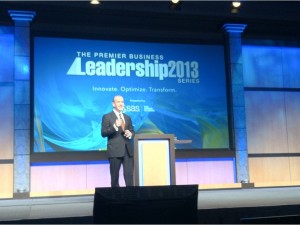
Sir Terry Leahy speaks with the clarity and purpose of someone used to speaking the language of data. When he was CEO of global retail giant Tesco, he presided over an organization that became the UK’s biggest retailer and enjoyed sustained robust growth - more than 10% annually over 20 years. Early in his tenure, he concluded that Tesco should stop following a strategy of catch-up compared to rivals Marks & Spencer and Sainsbury, and instead start leading through market knowledge, which led to his success in devising and implementing the Tesco Clubcard loyalty program and also successfully monitoring the shopping habits of Clubcard holders.
In Leahy’s words, “Clubcard transformed the productivity of marketing by 1000% because then offers could be tailored to what people actually wanted to buy.” And the key to the tailoring, of course is the analytics they used on the customer data they collected. That’s now a best practice among leading organizations whose business is transactional, but what’s noteworthy is that all began at Tesco nearly two decades ago and it coincides with their remarkable trajectory.
Leahy was keynote speaker at the Premier Business Leadership Series and he presented “Leadership, Transparency, Innovation and Growth,” based loosely on his book, Management in 10 Words. What stood out for me from his words crystallized nicely as he took questions from the audience. It was at that point when it all came together that the language of business is data, and in order for marketing to be heard it needs to speak the language of data.
Leahy related that “the voice of the customer is hard to argue with around the Boardroom table.” So for marketing to be effective, you need the combination of hard data with the compelling story from the customer viewpoint in order to drive the internal alignment that drives the business forward.
Even beyond the Boardroom, he emphasized the big correlation between employee values and customer satisfaction. Tesco listened to employees and embraced their view they get of how customers currently see Tesco, as well as how they wanted the customers to see Tesco. Those two statements, respectively, are the two statements of corporate value:
- No one tries harder for customers.
- Treat people how we like to be treated.
One point made his background in marketing crystal clear – if you follow the customer, you’ll never have to search for growth. Then he proceeded to provide example after example of how their disciplined use of analytics enabled cross-organizational alignment around customer priorities :
– Product development for value shoppers and gourmands alike,
– Knowing how much lettuce is sold in specific stores on a given day, which enables them to drive how much lettuce is picked locally and delivered to those stores by the next day.
– Providing online shoppers with their subset of 600 or so past purchases and likely purchases versus overwhelming them with all 50,000 possibilities offered by Tesco.
And the central thread to all that innovation, alignment, leadership and growth is the use of data and analytics to learn about the customer and to keep the customer's priorities in mind. For more details about how marketing analytics can help you do that, register to download Leverage Marketing Analytics to Improve the Customer Experience. As always, thank you for following!

2 Comments
Thanks John, great post!
Thanks for the comment, Pekka!